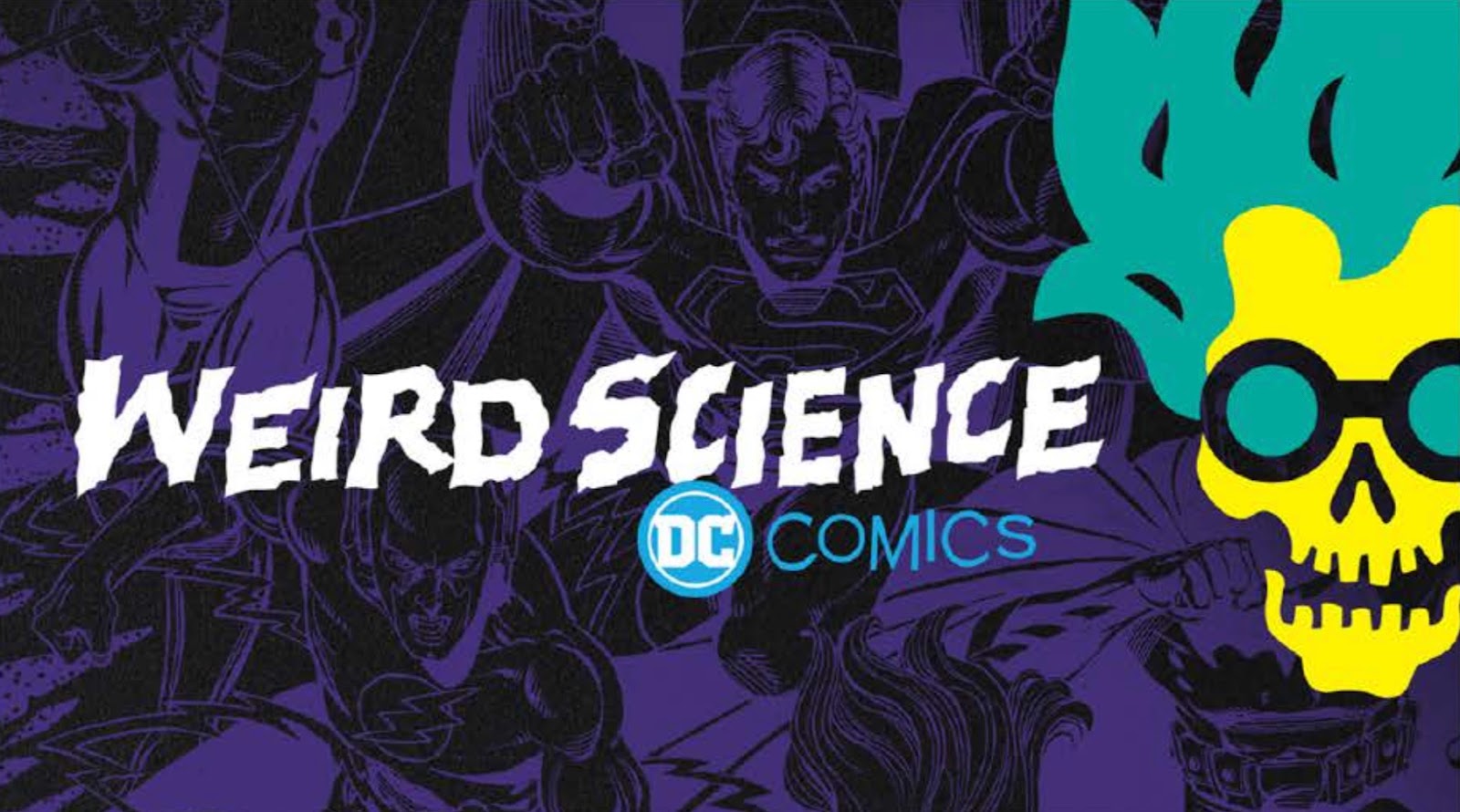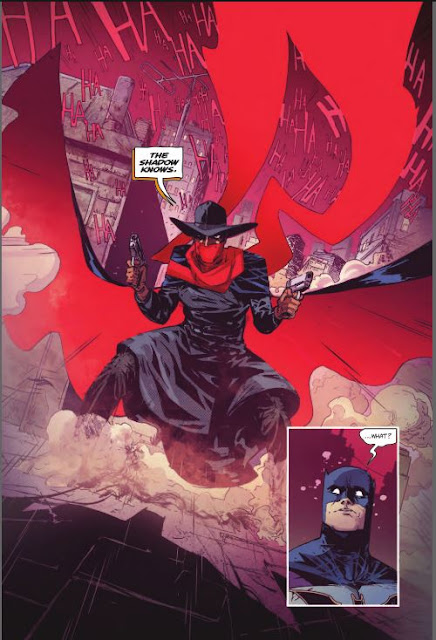Swirling Shadows, Mystifying Misdirections
Story by: Scott Snyder and Steve Orlando Art by: Riley Rossmo
Art by: Riley RossmoColours by: Ivan Plascencia
Letters by: Clem Robins
Published by: DC Comics/Dynamite
Cover price: $3.99
The idea of a crossover series featuring Batman and The Shadow is, on the surface, a no-brainer. The two characters are both alter egos of extraordinarily rich men who deploy an array of resources – both technological and human – to fight crime. Both operate in the shadows, both routinely break the law, and both struggle with their pasts. And both are multi-media properties who have their roots in the pulp era. While Batman has undoubtedly eclipsed The Shadow in popularity, it’s worth remembering that, in the late 30s, The Shadow was appearing in a range of media (including a radio serial starring Orson Welles) and that Batman co-creator Bill Finger has readily acknowledged The Shadow’s influence on the development of the ‘dark knight’. Batman’s debut story, Finger has also admitted, was heavily influenced by a Shadow tale. With all this in mind, seeing The Shadow and Batman work side by side is an intriguing – if not outright mouth-watering – prospect. But that isn’t what we get…
We start the issue with a short one-page scene featuring a meeting between Bruce Wayne and Henri Ducard which takes place at Ducard’s retreat in the French Alps. This turns out to be a framing sequence as we return to their conversation at the issue’s close. Now, Ducard is an interesting character not least because he has a certain history with Bruce/Batman. Perhaps most famous for being played by Liam Neeson in Batman Begins, Ducard is a decidedly murky figure who had a hand in training Bruce in his pre-Batman days. Whatever his background, it seems Bruce needs his help in unravelling a particularly difficult mystery. The narrative takes us back a week to show us just what that mystery is.
The next page is mostly a very impressive depiction of Arkham Asylum, leaves swirling atmospherically in front of its wrought iron gates. We are shown an unidentified porter doing his rounds handing out food to some of the more famous inmates, although I’m fairly sure he’s going way beyond asylum regulations in giving, for example, Poison Ivy “deep fried tarantula”. As bizarre as this sequence is, it’s entertaining enough and I must confess I did chuckle at Riley Rossmo’s depiction of Maxi Zeus lighting up a light bulb held between his teeth, presumably in an attempt to exercise (and prove) his ‘divinity’. We follow the porter home where he has a promising phone conversation with the man with whom he had a date the previous night. His ability to acquire exotic meals for homicidal lunatics notwithstanding, our nameless porter seems like a nice guy. He has a cute dog in some kind of wheeled harness, he likes Chinese take-out and he might be about to take the next step in a relationship with someone who obviously finds him pretty great. So, of course, he’s going to die on the next page.
And die he does. Again, the art is impressive with a particular focus on the dropped take-out (some kind of prawn dish, it would seem) which is spattered with blood. The statement “I am an honest signal” appears at the bottom of the page, we turn over and now the apartment is a crime scene crawling with cops, who engage in the kind of banter fictional policemen always seem to use when confronted with violent death. Batman shows up; Renee Montoya gives him the room. And I experience the first jolt of uncertainty. Our dead man is Lamont Cranston. Not only is he the first murder victim in this apartment block (that Batman notes this is a bit weird – does he have a scorebook for this kind of thing?), but he’s bearing the name of The Shadow’s real identity. Which can’t be right, can it? Hmmm.
Then Cranston’s killer (or certainly the man whom Batman believes is Cranston’s killer) turns up, a… ahem… ‘shadowy’ figure in a broad-brimmed hat, and he turns out to be, of course… The Shadow. Oh, there are one or two things to say here. The page in which The Shadow is revealed is awesome. Rossmo’s art is poster-worthy here and Batman’s befuddled expression is a perfect reflection of my own when I read this. The pages leading up to that revelation are less wonderful. It is unusual for me to be quite so conflicted about an artist, but in Riley Rossmo’s case it’s impossible not to be. While some of his art is gloriously atmospheric, some of his more mundane panels are too ragged, too impressionistic to follow clearly. There is, to be fair, a very kinetic feel to the fight between Batman and The Shadow, but Rossmo’s decision to draw The Shadow mostly in silhouette in order to delay the revelation of his identity (and, presumably, highlight the character’s supernatural nature) is undermined, not only by the fact that The Shadow possesses one of the most easily identifiable silhouettes in the whole of pulp fiction, but also because it makes the fight too difficult to follow. I’m still not entirely sure if Batman punched The Shadow in the groin. It kind of looks like he did, but who knows? He’s laughing about it afterwards anyway.
Then… there’s the dialogue.
I must admit I had a mixed reaction on seeing this issue’s cover. On the one hand, it is really rather striking. Perhaps that red is a bit too bright, but seeing two tough and resourceful characters together – and particularly The Shadow with both guns blazing – is, well, pretty cool. On the other hand, there are names on that cover that, perhaps a little unfairly, give me pause, chief among them that of Steve Orlando who shares the writing duties with Scott Snyder. I’m not party to the inner workings of DC’s creative processes, but I strongly suspect that this is Snyder’s overall story and Orlando is mostly responsible for dialogue. It certainly reads like it.
Now, I understand that it’s probably foolish to expect entirely naturalistic dialogue from people who go around at night dressed in capes and cowls, but there’s a trend of heroes speaking about themselves in pompous overblown ways that thoroughly annoys me and Orlando indulges in it here. When The Shadow disappears at the end of his inclusive fight, Batman cries out, “Whoever you are, I hope you’re listening. Bats live in the shadows. I’m coming for you.” This all makes Batman seem remarkably weak – and just a little unhinged. I’d much rather have him realise he’s just been confused by The Shadow’s supernatural ability to cloud men’s minds, but I’m perhaps expecting too much here.
That said, some of the dialogue works considerably better. Renee Montoya’s feels very realistic and the writing team are good at evoking character and background very economically at times. At others, though, characters do speak like they’re refugees from a Victorian melodrama with a tendency to pontificate that is both jarring and faintly ludicrous. This includes a very weird-looking bellhop who reads far too much into a disguised Bruce Wayne’s small talk. But, I’m getting ahead of myself.
The rest of the issue is taken up with Batman – in a variety of guises, including a version of Matches Balone whose moustache amusingly flies off in the middle of a fight – tracking down members of The Shadow’s network of informants and assistants or, in a couple of cases, their descendants. The Shadow, it seems, operated out of Gotham in the 30s (oddly enough, so did Bat… oh, hang on) but there’s no clue as to how he’s still around now. Batman does manage to penetrate The Shadow’s inner sanctum, however, and finds evidence of his grandfather’s involvement with Cranston in the 30s as well as a clue that leads him back to… Ducard. So we end the issue as we began – with a conversation between Ducard and Bruce Wayne which ends in a manner that I suspect the creative team meant to be shocking and dramatic but I found abrupt, confusing and a little anti-climactic.
So, what to make of all this? I’m honestly not sure. In one sense, this is a better story than I might have expected. Rather than a straightforward team-up between the two characters, Snyder and Orlando have chosen to make The Shadow himself the mystery that Batman is determined to solve. That’s a decision whose boldness I can’t help but admire. The problems I have with this issue lie in its execution. While linking The Shadow to an already established character like Ducard is an interesting move, Orlando’s dialogue and Rossmo’s art are both inconsistent and the plotting is a bit lax at times. We never do see Renee Montoya come back from her cigarette break and, once he’s encountered The Shadow, Batman’s investigation of Cranston’s death seems to exclude co-operation with the GCPD entirely. While it’s nice to see Cranston’s love interest Margo Lane again, she yields up important information surprisingly easily. Perhaps she’s hoping that Batman can save him, but that’s by no means clear from the writing.
Bits and pieces:
While I like the central idea, it’s far too early to tell if this will turn out to be a great story. At this early stage, there’s certainly a lot of potential, although I’m not as confident as I’d like to be that the potential will be fulfilled. The mystery around The Shadow’s identity and his links with Henri Ducard are enough to make me interested in reading the next issue, but some of the inconsistencies in both art and writing make me unsure whether I’ll enjoy it all that much when I do.





Good call Jeremy. I enjoyed it, but too early to tell if it's going to be another "All-Star Batman".
ReplyDeleteBatman/Oneofthemanycharactershesrippedoff.
ReplyDeleteWhat an interesting duo.
I found this book really refreshing. It's the best Batman I've read in a long time because it was fun. Plus, Matches Malone! I really enjoyed the pulpy dialogue. Far better than having the characters trudging around like zombies repeating, "I am..." every page. My only issue was how stocky Batman was drawn. I can't see someone that beefy having the agility to leap across rooftops.
ReplyDelete